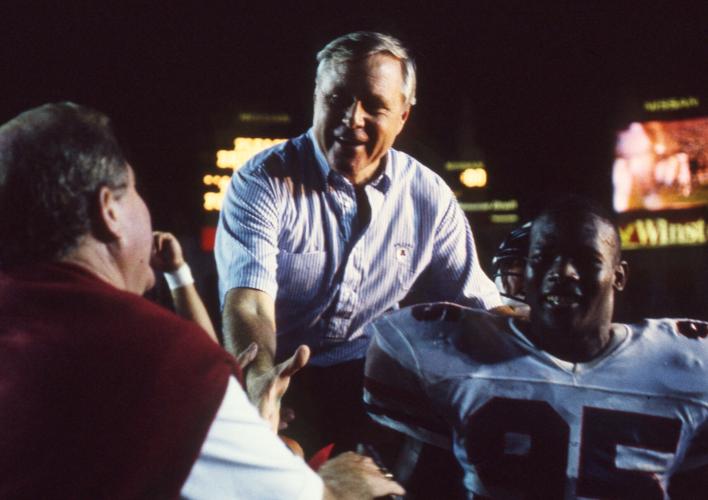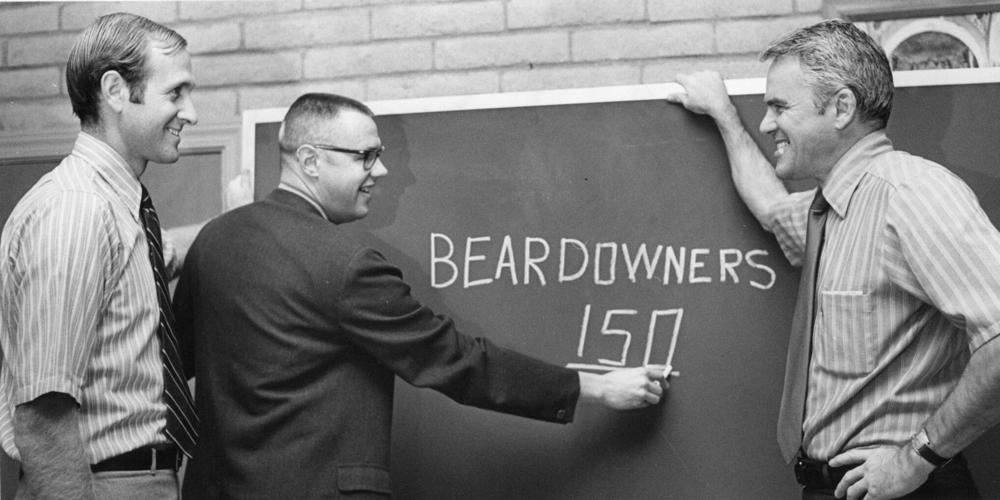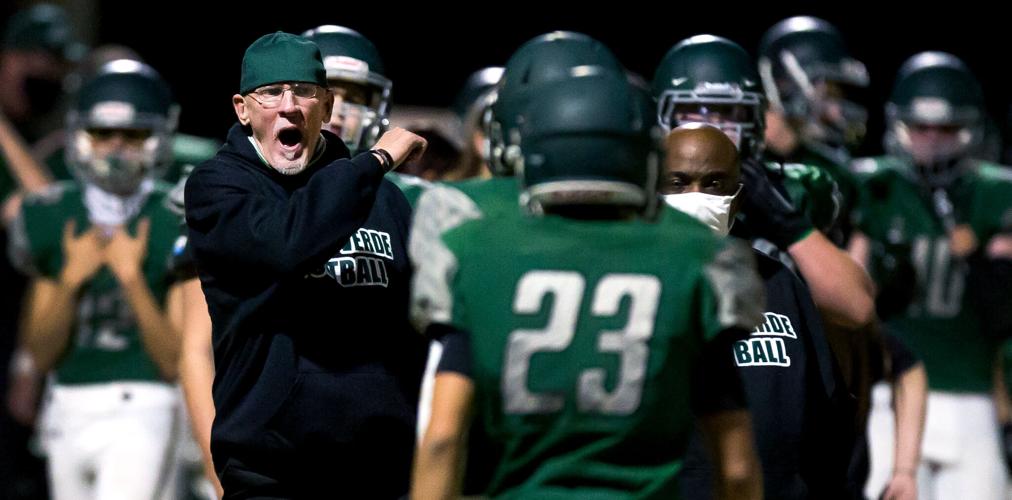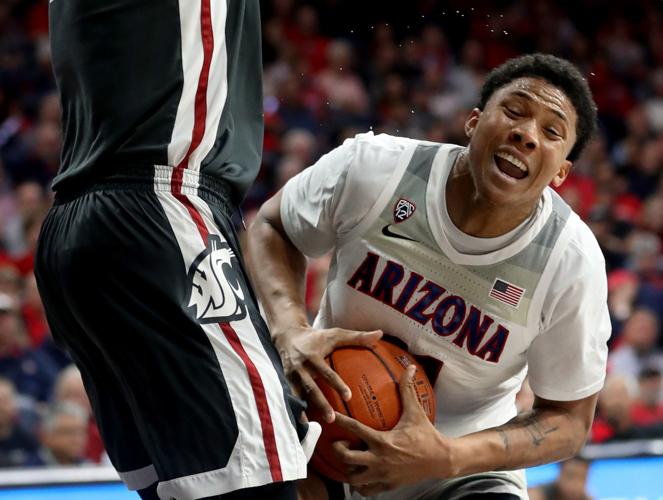The Star's longtime columnist remembers Dick Tomey, explains why Jay Dobyns is poised to succeed at Tanque Verde, lists his favorite lefties in UA basketball history and more.
Canceled UA opener reminds us there’s more to life than football
My brother is a high school athletic director in my Utah hometown. His team is 9-1, advancing to the third round of the playoffs this week with a state title in view. At many games, fans have packed every seat in the bleachers.
Unlike the Pac-12, there is no daily, cutting-edge antigen testing at my high school. Parents make the call if their sons are available or not. Yet the games go on. Only two high school players have missed games due to COVID-19, which was the same number of Pac-12 football games canceled last week.
But as we have learned, daily antigen testing is not a cure-all. The coronavirus is totally unpredictable, nondiscriminatory, day by day and place to place.
As Arizona prepared to play Utah in Salt Lake City last week — 80 miles from my hometown — I had a strong feeling the game would be canceled. Utah governor Gary Herbert told the Salt Lake Tribune that daily infections broke a record on Thursday (2,897 cases) and then added this:
“It’s grim news. It’s very discouraging. We’ve been warned by our medical professionals, our data scientists, that this is going to over run our medical facilities.”
The Utah-Arizona game was soon canceled. But losing a football game is far from grim news.
The fallout? The Wildcats may be on the hook for more than $100,000 for a charter flight, hotel rooms and food service that was contracted. There will surely be no Rose Bowl for Arizona or Utah. The league and teams won’t split several million dollars from ESPN for a game that wasn’t televised. But so what?
Nobody died. Nobody is in the ICU on a respirator.
In my lifetime, college football was forever put in context by Arizona coach Dick Tomey in September 1995.
After the 17th-ranked Wildcats rallied to beat Georgia Tech on a Thursday night at Arizona Stadium, the door to the normally accessible Arizona postgame locker room interviews remained closed for 30 or 40 minutes.
When the door finally opened, dozens of Wildcat football players were weeping, as were a few adults. Tomey had informed his team that senior tight end Damon Terrell died that day at a Tucson hospital; Terrell died from complications of heatstroke and a ruptured spleen, life-threatening incidents that occurred at practice a month earlier.

Damon Terrell died September 1995.
When Arizona traveled to Illinois the following week, it held a walk-through practice late Friday afternoon. My Star colleague Anthony Gimino and I were allowed to stand nearby as Tomey spoke to the team, informing them he was immediately leaving for the airport to catch a flight to Los Angeles. He would not be at the game the next day; he would be at Terrell’s funeral.
He solemly added that the 24-year-old daughter of Illinois offensive coordinator Paul Schudel had died a day earlier.
No one made a sound; it seemed like too much bad news to process.
“Don’t worry about it if you lose,” Tomey said. “It’ll be OK.”
When Illinois beat Arizona 9-7 a day later, taking advantage of five UA turnovers, receiver Rodney Williams took his coach’s advice to heart. “There are a lot of things worse than losing this game,” he said.
Now, a quarter-century later, first-year Palo Verde High School football coach Mike Wells accompanied his team for Friday’s scheduled and long-delayed season opener at Pueblo High School.
When Wells arrived at Curly Santa Cruz Stadium, he was told there would be no game. COVID-19 issues at Pueblo led TUSD administrators to close the stadium.
It was just as disappointing for Pueblo as for Palo Verde; first-year Pueblo coach Jake Allen had waited months to see his team play.
Everybody went home.
On Saturday morning, Pueblo principal Frank “Sammy” Rosthenhausler supplied Tomey-like perspective to the canceled football game.
“Although I understand the difficult scenario we find ourselves,” he told me, “last night’s late cancellation was emotionally draining for our kids and coaches.
“Tomorrow is a promise to nobody right now — but when ‘today’ is ripped from kids with such suddenness, it isn’t easy to manage emotionally.”
In 1995, Arizona’s football season continued. The Wildcats ended the season by stunning ASU to win the Territorial Cup.
This week, Palo Verde is scheduled to return home to play Santa Rita. Pueblo is to travel to play rival Cholla. And the Wildcats are scheduled to play USC at empty Arizona Stadium. Maybe one or all of those games will be canceled, too.
In a bigger picture, the important thing is that life goes on with or without football.
Ex-Cat Jay Dobyns gets it done with first win

Tanque Verde coach Jay Dobyns yells instructions to players during their 49-10 win over Rincon/University on Friday night.
When Tanque Verde High School hired 59-year-old Jay Dobyns to be its football coach last spring, it seemed like something of a gamble. Dobyns had never been a head coach. He is a best-selling author and motivational speaker, a busy man who travels around the country, a Sahuaro High School grad and former ATF agent who was a second-team All-Pac-12 receiver at Arizona in 1984.
With Dobyns, it was going to be a hit or a miss — nothing in between. He doesn’t do halfway. His “all-in” style was immediately apparent when he stocked his coaching staff with prominent Tucson football names like Jeff Kiewel, David Adams and Julius Holt, among others.
Tanque Verde has been one of Tucson’s least successful football teams, at any level, for the last decade. Dobyns inherited a team that went 0-10 a year ago, losing games 63-0, 61-14, 51-7 and 63-8. But on Friday night, Tanque Verde routed Rincon/University 49-10. Dobyns and his club have just four regular season games remaining on a truncated schedule, but who cares? The instant positivity is pure Jay Dobyns.
Here’s hoping that Dobyns finds that being a head coach is part of his DNA and he sticks with it for more than a few years.
It’s odd that Dobyns is one of the few former standout-level players from the UA to become a high school football head coaches in Tucson. The list is a short one.
Murl McCain was Amphitheater’s first coach in the 1940s and 1950s; Ev Nicholson did so well at Catalina that it named the football stadium in his honor; Jerry Davitch had success at Salpointe Catholic in the early 1970s; Larry McKee made an impact at several TUSD schools; and, more recently, Vincent Smith at Tucson High and Paul Schmidt at Mountain View became head prep coaches in the city where they played college football. John Kaiser, at Catalina, and Sammy Giangardella, at Sahuaro, spent one season as head coaches.
The three leading notable ex-Wildcats in terms of overall success in Tucson prep football were Ed Brown at Cholla, 1969-87, Howard Breinig at Rincon and Sahuaro, who won a state co-championship in 1994, and, of course, Tucson High’s Rollin Gridley, who led the Badgers to five state championships between 1937-45.
Ex-Wildcats coach Bruce Larson part of UA reunion

Bruce Larson, right, was head coach of the University of Arizona basketball team from 1961-72.
Bruce Larson was Arizona’s basketball coach from 1961-72, stuck in antiquated Bear Down Gym as his WAC opponents Utah, New Mexico and BYU built grand new arenas. Finally, when Arizona built McKale Center in 1972, Larson and the school parted ways. He was not a bitter man. Each time I’ve asked Larson about his UA days, he says “I played the cards I was dealt.” Now 94, an active golfer for most of the last 25 years, Larson enjoyed a reunion with many of his former Wildcats last week, gathering at the home of former All-WAC guard Warren Rustand. One of Larson’s top players, All-WAC forward Albert Johnson, a former UA assistant coach, also attended the reunion, along with Buddy Doolen, an All-State guard at Catalina High School who went on to win 381 games as head coach at Mesa Westwood High School. Also attending the reunion were former UA basketball players Dennis Albright, Tom Lavoy and Ken Kurtz. …
Brent Newcomb returns to Tucson
It is good to see one of Tucson’s top names in the golf industry, Brent Newcomb, return to town to be the director of golf at the Omni Tucson National. Newcomb spent the last few years as the general manager at Phil Mickelson’s Chaparral Pines facility in Payson. Before that, the Mountain View High School and Pima College grad was the head pro for eight years at the Stone Canyon Club, where Mickelson will stage a day-after-Thanksgiving exhibition with Peyton Manning, Charles Barkley and Steph Curry. Newcomb won the 2013 PGA Southwest Section championship and has operated the Ricki Rarick Junior golf program in Tucson. …
'Voice of the Sun Devils' stays home
One of the changes forced by the coronavirus pandemic is that many TV and radio operations — from ESPN to college sports — are no longer doing on-site broadcasts. Arizona State, for example, did not send distinguished play-by-play man Tim Healey to Saturday’s ASU-USC game at the Los Angeles Coliseum. Instead, Healey worked from Tempe after a second-floor conference room at ASU’s Carson Center was equipped with TV monitors and became Healey’s new home for the 2020-21 football and basketball seasons. It’s not only a safety measure but a cost-reducing move that led to many of the 500 layoffs at ESPN last week and is likely to spread through the NCAA. . …
Ex-Cat Khalil Tate selling gear

Former Arizona quarterback Khalil Tate last week tweeted that he is marketing and selling apparel on khaliltate14.co. Indeed, Tate’s image and likeness are available on hoodies and T-shirts — apparel that says “Mr. October” — for $25 to $50 and up. Had the NCAA’s pending name-image-likeness proposals been in place when Tate had four unforgettable games in October 2017, he might’ve been able to earn five figures, maybe $100,000 or more, before opposing defenses figured out a way to limit his production. Now? Not as much.
Lee’s late to “Lefty U” scene

Arizona forward Ira Lee (11) bounces off Washington State center Volodymyr Markovetskyy (15) on his drive into the lane in the first half of their Pac12 game at McKale Center, March 5, 2020, Tucson, Ariz.
In a Zoom media conference last week, Arizona senior basketball forward Ira Lee said that UA freshman forward Azuolas Tubelis is a “silent killer. … he might be one of the best left-handed players I’ve ever played with.”
Before Lee arrived at McKale Center, before Tubelis enrolled at Arizona, the Wildcats long ago established its basketball program as “Lefty U” as much as “Point Guard U.”
The list of “killer” left-handed shooters at Arizona is a long one: Damon Stoudamire, Salim Stoudamire, Michael Wright, Rondae Hollis-Jefferson, Bison Dele, Matt Othick and now women’s basketball star Aari McDonald. That’s a Super Seven almost unmatched in college basketball.
Try picking the order of best lefty shooters from that list. I’d start with the Stoudamires and put McDonald a close No. 3.
The Pac-12 has similarly been blessed with high-profile lefties, including consensus All-Americans Harold Miner of USC and Ed O’Bannon of UCLA.
My two cents: Cutting track a bad look for Clemson
Of all the college teams to eliminate sports, Clemson would’ve been about the last to earn any sympathy about “lost revenues” during COVID-19.
Even money-challenged Arizona, Oregon State, Cal and Washington State have resisted eliminating sports the last six months.
Clemson last week eliminated men’s track and field. It wasn’t long ago that the school elevated the standard for football facilities, constructing a $55 million, 142,000-square-foot wonder-world that includes a weight room, meeting rooms, a nutrition area and player lounge.
The Reeves Football Complex includes a nap room, basketball court, Wiffle ball field, miniature golf course, bowling lanes, barber shop, nap room, a slide between the first and second floors and a room dedicated only to displaying Clemson’s Nike gear.
For a few years, I enjoyed Clemson’s rise in college football, an underdog of sorts against the Alabamas and LSUs. Now? I’d put Clemson with Oregon among my personal picks of teams who can’t lose enough.










